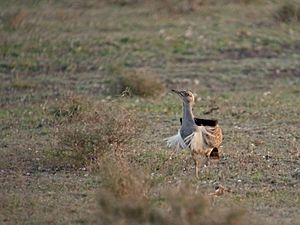Canarian houbara facts for kids
Quick facts for kids Canarian houbara |
|
|---|---|
 |
|
| On Lanzarote, Canary Islands, Spain | |
| Conservation status | |
| Scientific classification |
|
| Kingdom: | Animalia |
| Phylum: | Chordata |
| Class: | Aves |
| Order: | Otidiformes |
| Family: | Otididae |
| Genus: | Chlamydotis |
| Species: | |
| Subspecies: |
C. u. fuertaventurae
|
| Trinomial name | |
| Chlamydotis undulata fuertaventurae Rothschild & Hartert, 1894
|
|
The Canarian houbara (Chlamydotis undulata fuertaventurae) is a large bird that belongs to the bustard family. It is a special type, or subspecies, of the houbara bustard. This bird lives only in the eastern Canary archipelago, which is a group of islands in the North Atlantic Ocean.
It is quite rare and faces threats, meaning its numbers are low. The Canarian houbara does not migrate; it stays in the Canary Islands all year round. It is also the animal symbol for the island of Fuerteventura.
Contents
What is the Canarian Houbara?
The Canarian houbara is one of three subspecies of the houbara bustard. Scientists believe it has lived in the Canary Islands for a very long time, possibly between 130,000 and 170,000 years. However, some genetic studies suggest that this specific subspecies became separate from others more recently, about 20,000 to 25,000 years ago. This means there might have been two times when these birds arrived on the islands.
How to Identify a Canarian Houbara?
The Canarian houbara looks a bit different from other houbara subspecies. It is smaller and has less sandy (or yellowish-brown) coloring. It also has darker and more widespread markings on its back. This bird is the largest native bird found in the Canary Islands.
Where Do Canarian Houbaras Live?
Canarian houbaras are found on the islands of Fuerteventura, Lanzarote, and Graciosa. It is not certain if they still live on Lobos Island. In the past, they also lived on Tenerife and Gran Canaria, but they are no longer found there.
These birds live in dry, flat areas, rocky hills, and sand dunes that do not move. These places have only a few bushes and grasses. They sometimes look for food on farms early in the morning and at dusk. However, they stay away from towns, cornfields, forests, and areas with lava rock. The areas where they live get very little rain, usually less than 140 millimeters (about 5.5 inches) per year. The temperature is usually mild, ranging from about 16°C (61°F) in winter to 24°C (75°F) in summer.
How Do Canarian Houbaras Behave?
Breeding Habits
Outside of the breeding season, these birds might gather in small groups to find food. But when it's time to breed, the males claim and protect their own areas. These areas can be quite large, about 500 to 1000 meters (1,600 to 3,300 feet) across. During this time, both male and female birds tend to be alone, only meeting to mate.
Courtship happens from December to March. The male bird shows off his head and throat feathers while walking in a line or circle to attract a female. The female lays two or three eggs in a shallow nest on the ground between February and April. Males usually mate with more than one female and do not help raise the young. After hatching, the baby birds, called chicks, can move around soon after birth and stay with the female. Usually, only one chick from each group of eggs survives, and rarely two.
What Do Canarian Houbaras Eat?
Canarian houbaras eat both plants and animals. They find their food on the ground. Their diet includes many different arthropods (like insects and spiders), molluscs (like snails), and smaller vertebrates (like small lizards). They also eat various plant materials. Young chicks need to eat insects to grow big and strong.
Why are Canarian Houbaras Endangered?
In 1995, experts estimated that there were about 700 to 750 Canarian houbaras in total. About 300 to 350 were on Fuerteventura and Lobos, and 400 on Lanzarote and Graciosa. However, a later study found fewer birds on Fuerteventura, estimating only 177.
Even though they are listed as endangered in Spain and are protected by law, these birds face several dangers. Their homes are being destroyed by new buildings and developments. More tourism also causes them stress. Other threats include illegal hunting, hitting powerlines, and being disturbed by people looking for truffles.
See also
 In Spanish: Hubara canaria para niños
In Spanish: Hubara canaria para niños
- List of animal and plant symbols of the Canary Islands
Images for kids




